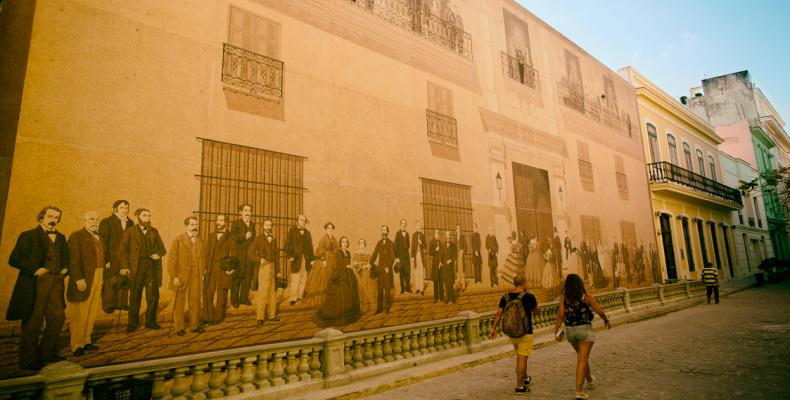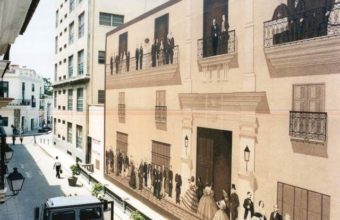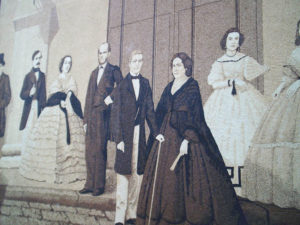 THE MERCADERES STREET, LA HAVANA AND THE UNPRECEDENTED ‘MURAL OF THE PERSONALITIES’.
THE MERCADERES STREET, LA HAVANA AND THE UNPRECEDENTED ‘MURAL OF THE PERSONALITIES’.
Mercaderes Street (Calle Mercaderes) is one of the best preserved streets in the historic center of the capital of Cuba. Narrow, cobbled and pedestrian in which stand the immense doors of precious woods, canopies and old lamps.
We can easily walk its four blocks of extension, start at Tacón Street near the Cathedral of Havana and ends at the historic Plaza Vieja. Today, it is populated by museums, shops, restaurants and social projects, which is almost a replica of the original street dating from the 18th century.
From there, it inherits its name as a reflection of the immense commercial movement in the establishments of fine fabrics, gold, silver and other goods disposed in them to consume by the Habaneros of the time.
The transfer does not diminish, but it is difficult to travel by Mercaderes between O’Reilly and Empedrado and not stop before the “Mural of the Personalities” that pays tribute to the illustrious of the nineteenth century there perpetuated.
The mural was erected on an old stone wall that degraded the view of the centenary artery and is a faithful copy of the former palace of the Marquis of Arcos, headquarters of the Artistic and Literary Lyceum of Havana around 1844, an institution that the work vivifies, a place that welcomed the most select personalities of Cuban culture.
In the work of the Mural, imaginary scene of walk, in front of the facade of the Palace of the Marquis of Arcos, appear the illustrated independentistas warriors Carlos Manuel de Céspedes, the “Father of the Fatherland” for the Cubans, Gertrudis Gómez de Avellaneda, the Bishop Sword, the Countess of Merlin; Brindis de Salas (only once, at ten years old, he played in his salons) and the poet Placido, both excluded by the color of their skin.
The author, Andrés Carrillo, made a thorough research beforehand about the time and used in it a novel material in Cuba that includes a natural stone texture prepared to a specific grain size and embedded in acrylic resin. The mural also had the work of the architect Jaime Rodríguez, the sculptor Nicolás Ramos Guiardinú, several students of the San Alejandro School and some institutions.
Of great strength and durability in the open air and time, with four colors (brown, coral pink, black and light beige) it obtained a tonal range of 13 tints that gave it a perfect finish to “draw” the illustrious.
The plastic work concluded on December 27 of the year 2000, (approximately 300m² and composed of 52 panels) and reproduces in full size and accurately the 67 figures that make it up.
Not all the important personalities coincide exactly with the time that is recreated, some were proposed by the Historian of the City, Eusebio Leal Spengler, so that this amalgam pays homage to the national culture and our homeland history. With the irruption of what would be the Ten Years’ War, in 1868, the polarization of opinions and the increase in the repression of opposition political activities, the Liceo began to languish, as several of the members of its board of directors emigrated. and others declared themselves supporters of the pro-independence formula, and finally closed its doors in April 1869.
A work, the imposing mural. “Unprecedented in the Cuban mural” for being exposed to passers-by and a lesson in history, according to its author.
 LA CALLE MERCADERES, HABANA Y ÉL SIN PRECEDENTES “MURAL DE LAS PERSONALIDADES”.
LA CALLE MERCADERES, HABANA Y ÉL SIN PRECEDENTES “MURAL DE LAS PERSONALIDADES”.
La Calle Mercaderes es una de las calles mejor conservada del núcleo histórico de la capital de Cuba. Estrecha, adoquinada y peatonal en la que destacan las inmensas puertas de maderas preciosas, tejadillos y antiguas lámparas.
Podemos recorrer fácilmente sus cuatro cuadras de extensión, inicia en la Calle Tacón cerca de la Catedral de La Habana y termina en la histórica Plaza Vieja. En la actualidad la pueblan museos, tiendas, restaurantes y proyectos sociales, lo cual constituye casi una réplica de la calle original que data del siglo XVIII.
De ahí hereda su nombre como reflejo del inmenso movimiento comercial en los establecimientos de tejidos finos, oro, plata y otras mercaderías dispuestos en ellos para consumir por los habaneros de la época.
El trasiego no disminuye, pero resulta difícil transitar por Mercaderes entre O’Reilly y Empedrado y no detenernos ante el “Mural de las Personalidades” que rinde homenaje a los ilustres del silgo XIX allí perpetuados.
El mural se levantó sobre un añejo muro de piedra que degradaba la vista de la centenaria arteria y es copia fiel del otrora palacio del Marqués de Arcos, sede del Liceo Artístico y Literario de La Habana hacia 1844,institución que la obra vivifica, lugar que acogió a lo más selecto de las personalidades de la cultura cubana.
En la obra del Mural, imaginaria escena de paseo, frente a la fachada del Palacio del Marqués de Arcos, aparecen los ilustrados guerreros independentistas Carlos Manuel de Céspedes, el “Padre de la Patria” para los cubanos, Gertrudis Gómez de Avellaneda, el Obispo Espada, la Condesa de Merlín; Brindis de Salas (una sola vez, a los diez años, tocó en sus salones) y el poeta Plácido, ambos excluidos por el color de su piel.
El autor, Andrés Carrillo hizo previo a su realización un minucioso trabajo de investigación sobre la época y utilizó en ella un material novedoso en Cuba que incluye una textura de piedra natural preparada a una medida del grano específica y embebida en resina acrílica. El mural, además, contó con el trabajo del arquitecto Jaime Rodríguez, el escultor Nicolás Ramos Guiardinú, varios alumnos de la Escuela de San Alejandro y algunas instituciones.
De gran resistencia y durabilidad a la intemperie y el tiempo, con cuatro colores (marrón, rosa coral, negro y beige claro) obtuvo una gama tonal de 13 tintes que le dieron un acabado perfecto para “dibujar” a los ilustres.
La obra plástica concluyó el 27 de diciembre del año 2000, (aproximadamente 300m² y compuesto por 52 paneles) y reproduce en tamaño natural y con exactitud a las 67 figuras que la integran.
No todas las importantes personalidades coinciden exactamente con la época que se recrea, algunas fueron propuestas por el Historiador de la Ciudad, Eusebio Leal Spengler, para que esta amalgama brinde homenaje a la cultural nacional y nuestra historia patria. Con la irrupción de la que sería la Guerra de los Diez Años, en 1868, la polarización de las opiniones y el incremento de la represión de las actividades políticas de oposición, el Liceo comenzó a languidecer, pues varios de los miembros de su directiva emigraron y otros se declararon partidarios de la fórmula independentista, y finalmente cerró sus puerta en abril de 1869.
Una obra, el imponente mural. “Sin precedentes en la muralística cubana” por estar expuesto a los transeúntes y una lección de la historia, según cataloga su autor.
Agencies/Radio Habana/Guadalupe Yaujar/ Extractos/Internet Photos/ Arnoldo Varona/ TheCubanHistory.com
THE CUBAN HISTORY, HOLLYWOOD.







